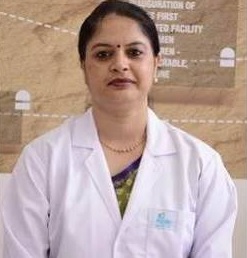Dilation and Curettage (D&C) - Procedure, Risks, Recovery
Dr. Arti Sharma

Treatment Duration
15 Minutes
------ To ------30 Minutes
Treatment Cost
₹ 20,000
------ To ------₹ 35,000

Table of Contents
- What is dilation and curettage?
- Need for Dilation and Curettage
- Benefits of Dilation and Curettage
- Before and On the Day of Dilation and Curettage
- Dilation and Curettage Procedure
- Recovery After Dilation and Curettage
- Risks and Complications of Dilation and Curettage
- Cost of Dilation and Curettage
- Takeaway
According to a study by Malik et al., 2023, about 77% of unintended pregnancies in India end in abortion. 1 This highlights the critical need for safe and effective procedures to terminate a pregnancy. DnC is one such surgical method used primarily to manage miscarriage and treat incomplete abortions.
Dilation and curettage, DnC full form, describes its dual components, which are dilating the cervix and curetting the uterine lining. The blog discusses the procedure, indications, and recovery of D&C in detail. Continue reading to find out.
Procedure Name | Dilation and Curettage |
Conditions Treated | Abnormal uterine bleeding, removing tissue remnants after miscarriage or abortion |
Benefits of Procedure | Minimally invasive, quick, faster recovery time |
Treated By | Gynaecologist or obstetrician |
You can check Dilatation and Curettage Cost here.
What is dilation and curettage?
DnC is a surgery used to remove the foetus and abnormal uterine tissue from the inside of the uterus. The procedure involves two main steps:
Dilation, where the cervix is widened to allow access to the uterus
Curettage, in which a surgical instrument (curette) is used to ablate the uterine lining and remove tissue
Anatomy and Physiology of the Uterus
The uterus is a pear-shaped hollow organ within the pelvis between the bladder and the rectum. It has four main parts:
Fundus (the top portion above the openings of the fallopian tubes)
Corpus (the central part where the fertilised egg implants)
Isthmus (where the uterus starts to narrow)
Cervix (the lower section that opens into the vagina)
The uterine wall is made up of three layers:
The innermost layer, or endometrium, lines the uterine cavity and sheds during the menstrual cycle.
The middle layer, or myometrium, is composed of smooth muscle. It expands during pregnancy to accommodate a growing foetus and contracts during labour.
The outermost layer, the perimetrium, covers the exterior of the uterus.
Dilatation and Curettage Videos by HexaHealth
Expert Doctors (10)
NABH Accredited Hospitals (10)


Need for Dilation and Curettage
D&C procedure is used to treat a variety of conditions affecting the uterus, providing both diagnostic and therapeutic benefits. The following are some of the reasons for performing dilation and curettage:
Diagnosing causes of abnormal bleeding and removing polyps or fibroids that may be causing the bleeding
Clearing out any tissue from the uterus after miscarriage or incomplete abortion to prevent infection or heavy bleeding
Treating significant bleeding after childbirth by clearing out remaining placental fragments from the uterus
Eliminating noncancerous polyps in the cervix or uterus
Treating molar pregnancy (tumours develop inside the uterus instead of the placenta during pregnancy)
Benefits of Dilation and Curettage
DnC as a surgical procedure offers significant benefits for diagnosing and treating various gynaecological conditions. These include:
Quick and Efficient: It is a relatively short procedure, often taking 15 minutes. Moreover, it is usually performed outpatient, minimising the time spent in a medical facility. This allows for a quick return to routine activities.
Minimally Invasive: Compared to other surgical alternatives, the D&C procedure involves minimal invasion. It leads to fewer complications and a faster recovery time.
Diagnostic Utility: D&C allows for the collection of uterine tissue samples. It can be crucial for diagnosing conditions like uterine cancer or the causes of abnormal uterine bleeding.
Therapeutic Benefits: The procedure effectively removes remnants of placental tissue following a miscarriage or abortion. This can prevent complications such as heavy bleeding or infection.
Before and On the Day of Dilation and Curettage
Preparing for a D and C procedure involves understanding the essential steps required before and on the day of the operation. Patients need to follow their doctor’s instructions closely.
Before Dilation and Curettage
Patients meet their doctor before a DnC to ensure they are prepared for the procedure. They should make sure to ask questions and clear all their doubts. The following is what they can expect:
Parameters | Prerequisites |
Pre-op Assessment |
|
Risk Evaluation | Allergies |
Restrictions | Blood-thinning medications |
Anaesthesia Selection | General or spinal |
Fasting | 8 hours before the procedure |
On the Day of Dilation and Curettage
Patients arrive at the hospital or clinic and complete any final paperwork. The following preparations may take place on the day of the procedure:
Parameters | Prerequisites |
Consent | Mandatory |
Surgical Preparation |
|
Physical Evaluation | Vitals check-up (breathing, heart rate, blood pressure, etc.) |
IV Line | Yes, for fluids and medications |
Dilation and Curettage Procedure
DnC is commonly performed in an outpatient clinic or hospital. It is completed within 10 to 15 minutes. The exact procedure can differ based on the patient’s condition. Generally, it involves the following steps:
Preparation: The patient is usually given anaesthesia to ensure comfort during the procedure. This can be:
General anaesthesia, where the patient is asleep
Spinal or regional anaesthesia, where the patient does not have any feeling from the waist down
Positioning: The patient is made to relax on the operating table in a lithotomy position. They lie on their back with their legs supported in raised stirrups.
Cervix Access: A speculum is inserted into the vagina to open the cervix. A clamp is used to help keep the cervix in place.
Dilation: The cervix is gently dilated using multiple rods to allow access to the uterus. This enables the passage of surgical instruments into the uterine cavity.
Curettage: The gynaecologist uses a curette, a spoon-shaped instrument, to scrape the lining of the uterus. This removes uterine tissue, which can be sent to a lab for analysis. Alternatively, a suction device may vacuum tissue out of the uterus.
Completion: After the procedure, the instruments are removed, and the speculum is withdrawn.
Recovery After Dilation and Curettage
It is usual to experience mild cramping and vaginal bleeding for 10-14 days after dilation and curettage. Following the doctor’s instructions in the hospital and at home can help a smooth recovery.
Recovery in Hospital
Patients can usually return home on the same day as the procedure. Before discharge, they can expect the following in the hospital or clinic:
They spend a few hours in the recovery room under observation. This ensures there are no immediate complications like heavy bleeding or adverse reactions to anaesthesia.
The nurse will monitor their vitals, including blood pressure, pulse, and breathing.
Once their condition stabilises, the patient will be discharged from the hospital. They will need someone to drive them home.
At-Home Recovery
After D and C surgery, individuals can resume their daily activities within one to two days. However, it is important to follow post-operative care guidelines to ensure a smooth healing process. These include:
Over-the-counter pain medications such as ibuprofen to manage mild discomfort and cramping
Use sanitary pads rather than tampons for bleeding to reduce the risk of infection
Avoid sexual intercourse or douching (washing the inside of the vagina with water or other fluids) for one week after the procedure or until the doctor says it’s safe
Shower instead of bathing and avoid swimming
Patients may expect a change in their next menstrual period. It may begin earlier or later than usual.
First Follow-Up Appointment
A follow-up visit is usually scheduled two weeks after the DnC procedure. During this appointment, the doctor ensures proper healing and discusses any further treatment if necessary. They will also perform specific tests to evaluate recovery. These include:
Pelvic exam
Ultrasound
Risks and Complications of Dilation and Curettage
Dilation and curettageare generally considered safe. However, like all surgical procedures, it carries potential risks and complications. Here are some issues that could arise:
Perforation of the uterus (instruments used during the D&C can puncture the uterus)
Heavy bleeding
Infection
Asherman’s syndrome (formation of scar tissue in the uterus, which can cause menstrual irregularities and infertility)
When to consult a doctor?
After undergoing a DnC, monitoring for any signs of complications is crucial. Women should contact their doctor if they experience the following symptoms:
Changing more than one sanitary pad per hour (extensive bleeding) or passing large blood clots
Fever above 100.4℉
Cramps for more than two days
Worsening pain
Foul-smelling discharge
Cost of Dilation and Curettage
The cost of the DnC procedure in India varies in different hospitals depending on several factors. Generally, it ranges between ₹ 8,000 to ₹ 11,000.
Procedure Name | Estimated Cost Range |
Dilation and Curettage | ₹ 8,000 to ₹ 11,000 |
Note: The price mentioned above is approximate. Please consult HexaHealth experts for accurate expenses.
The factors that can influence the cost of the procedure include:
Type of Facility: Choosing between a public hospital, private clinic, or speciality medical centre can significantly affect the cost. Private facilities generally charge more.
Geographic Location: Metropolitan areas have higher expenses due to increased living costs.
Type of Anesthesia: The cost can differ depending on whether regional or general anaesthesia is used. General anaesthesia is more expensive than regional anaesthesia.
Physician’s Expertise: More experienced gynaecologists or surgeons may charge higher fees for their services.
Additional Tests: The expenditure may increase if the D&C is part of a broader diagnostic process requiring further tests like hysteroscopy.
Takeaway
Dilation and curettage (DnC) helps diagnose and treat various uterine conditions. It addresses issues such as excessive bleeding and the removal of tissue after miscarriage. As a minimally invasive option, it minimises recovery time, allowing patients to resume routine activities quickly.
For those seeking information about the D&C procedure, HexaHealth can assist by providing access to a network of qualified gynaecologists. With expert guidance, we ensure patients receive personalised care for their reproductive health. Contact us today to have safe surgery.
Frequently Asked Questions (FAQ)
What is a DnC?
A DnC is a surgical procedure that involves dilating the cervix and scraping the uterine lining to remove tissue. It is used for diagnostic or therapeutic purposes.
What is the full form of D&C?
The DnC full form is dilation and curettage. It refers to the two main steps involved:
Dilating the cervix
Scraping (curettage) the uterine lining
Why is D&C performed?
A D&C procedure is performed for various diagnostic and therapeutic reasons. These include:
Diagnosing conditions related to abnormal uterine bleeding
Clearing out tissue in cases of miscarriage or incomplete abortion to prevent infection or heavy bleeding
Removing uterine polyps or fibroids
How is a D&C done?
DnC is performed under general or regional anaesthesia and takes 10-15 minutes to complete. The steps involved are as follows:
The cervix is dilated using increasingly larger rods
A curette is utilised to scrape the lining of the uterus to remove tissue
Once the procedure is complete, the instruments are removed
Is D&C a surgical procedure?
Yes, D&C is a surgical procedure that requires anaesthesia. It is conducted in a hospital or specialised clinic setting under sterile conditions to prevent infection.
What are the indications for D&C?
Dilation and curettage is performed for several clinical reasons, from diagnostic assessments to therapeutic interventions. Here are the key indications for undergoing a D&C:
Diagnosis and treatment of abnormal uterine bleeding
Removal of tissue post-miscarriage or abortion
Removing uterine polyps or fibroids
How many days rest after D&C?
After going home, patients are advised to rest for the remaining day. They can return to their daily activities in a day or two.
What not to do after a D&C?
Post-operative care is crucial to avoid complications after a D&C procedure. Patients should be aware of what not to do during the recovery period:
Avoid inserting tampons into the vagina
Refrain from sexual intercourse to prevent infection
Do not take baths (opt for showers instead)
Is D and C painful?
The DnC procedure can cause mild cramping, similar to menstrual pains. These cramps can be managed with over-the-counter pain medications.
What is dilation?
The term dilation refers to a medical procedure essential in various gynaecological interventions. It involves widening the cervix using specialised instruments or medications to facilitate access to the uterus.
Is D&C safe?
Yes, D&C is a safe procedure, and complications are rare. The overall mortality rate for this procedure is approximately 0.6 per 100,000, which, in some cases, makes it safer than childbirth.
What are the risks and complications of D&C?
DnC is generally considered safe, but like any surgical procedure, it carries some risks. These include:
Heavy bleeding
Infection
Uterine perforation
Scar tissue formation
Anaesthesia reactions (rare)
What is the recovery time after a D&C procedure?
The recovery time after a D&C procedure is typically short. Most patients can resume routine activities within 1-2 days. However, they may experience light bleeding or spotting for 10-14 days.
Can D&C be used for diagnostic purposes?
Yes, the D and C procedure can be used for diagnostic purposes. It is often performed to obtain tissue samples to diagnose conditions such as uterine cancer or the causes of abnormal bleeding.
Is anaesthesia required for D&C?
Yes, anaesthesia is required for a D&C to ensure the patient’s comfort and prevent pain during the procedure. The type of anaesthesia may be general or regional, depending on the specific circumstances and patient preference.
Can D&C be done in an outpatient setting?
Yes, D&C procedures can be done in an outpatient setting meaning it does not require a hospital stay. This allows patients to return home the same day, provided there are no complications or other medical concerns.
How long does it take to recover from D&C surgery?
Most patients recover from D and C surgery in a week. Some may experience light bleeding or spotting for 10-14 days, but major activities can usually resume within 1-2 days.
What post-operative care is needed after D&C?
Post-operative care is an important part of recovery to ensure the success of D&C. It includes the following steps:
Monitoring for excessive bleeding
Avoiding the insertion of anything into the vagina, such as tampons
Abstaining from sexual intercourse for at least a week
Can D&C affect future pregnancies?
A DnC can affect future pregnancies if it leads to the development of scar tissue inside the uterus, known as Asherman’s syndrome. However, this is rare, and many women go on to have successful pregnancies after the procedure.
Are there any restrictions on activities after D&C?
After a D&C, it is recommended to avoid heavy lifting and strenuous activities for a week or two. It allows the cervix to close and the uterus to heal. Normal activities can typically be resumed based on comfort level and doctor’s advice.
Is the D and C procedure covered under insurance?
Yes, D&C procedures are often covered under insurance, especially if they are deemed medically necessary. However, coverage specifics can vary. Therefore, patients are advised to consult HexaHealth experts to understand the policy details.
How much does D and C surgery cost?
The dilation and curettage cost can range between ₹ 8,000 to ₹ 11,000, depending on the facility fees, geographic location, and the doctor’s expertise. However, these prices are estimates. Consult HexaHealth experts for up-to-date expenses.
Dilatation and Curettage Cost Videos
More Treatment options
References
All the articles on HexaHealth are supported by verified medically-recognized sources such as; peer-reviewed academic research papers, research institutions, and medical journals. Our medical reviewers also check references of the articles to prioritize accuracy and relevance. Refer to our detailed editorial policy for more information.
- Malik M, Siaa Girotra, Mrunali Zode, Basu S. Patterns and Predictors of Abortion Care-Seeking Practices in India: Evidence From a Nationally Representative Cross-Sectional Survey (2019-2021). Cureus [Internet]. 2023 Jul 1;

- cleveland clinic. Uterus: Anatomy, Function, Size, Position & Conditions [Internet]. Cleveland Clinic. 2022.

- What Is a D&C? [Internet]. Cleveland Clinic.

- Mayo Clinic. Dilation and curettage (D&C) - Mayo Clinic [Internet]. Mayoclinic.org. 2016.

- Articles [Internet]. Cedars-Sinai. [cited 2024 Apr 20].

- John Hopkins Medicine . Dilation and Curettage (D and C) [Internet]. Johns Hopkins Medicine Health Library. 2019.

- Dilatation and curettage (D&C) [Internet]. www.healthywa.wa.gov.au.

- Cooper DB, Menefee GW. Dilation and Curettage [Internet]. PubMed. Treasure Island (FL): StatPearls Publishing; 2021.

Last Updated on: 26 June 2024
Reviewer

Dr. Arti Sharma
MBBS, DNB Obstetrics and Gynaecology, Diploma In Cosmetic Gynaecology
9 Years Experience
Dr Arti Sharma is a well-known Obstetrician and Cosmetic Gynaecologist currently associated with Aesthetica Veda in Bengaluru. She has 9 years of experience in Obstetrics and Cosmetic Gynaecology and worked as an expert Obstetrician...View More
Author

Sparshi Srivastava
B.Tech Biotechnology (Bansal Institute of Engineering and Technology, Lucknow)
2 Years Experience
An ardent reader, graduated in B.Tech Biotechnology. She was previously associated with medical sciences secondary research and writing. With a keen interest and curiosity-driven approach, she has been able to cont...View More
Dilatation and Curettage Cost in Top Cities
Latest Health Articles
Other Treatments in Your City
























